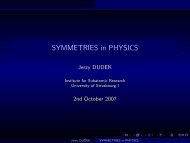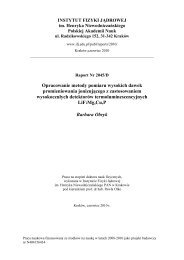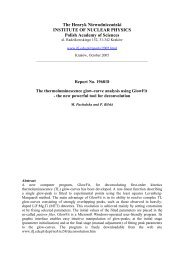Report No 1951/AP - Instytut Fizyki JÄ drowej PAN
Report No 1951/AP - Instytut Fizyki JÄ drowej PAN
Report No 1951/AP - Instytut Fizyki JÄ drowej PAN
You also want an ePaper? Increase the reach of your titles
YUMPU automatically turns print PDFs into web optimized ePapers that Google loves.
PROTON NMR STUDIES OF HARD DENTAL TISSUES UNDER FAST MAS<br />
Joanna Kolmas 1 , Zofia Paszkiewicz 2 , Anna Slosarczyk 2 , and Waclaw Kołodziejski 1<br />
1 Department of Inorganic and Analytical Chemistry, Medical University of Warsaw,<br />
ul. Banacha 1, 02-097 Warszawa, Poland.<br />
2 Stanislaw Staszic Univ., Min. And Mat. Faculty of Materials Science and Ceramics,<br />
Al. Mickiewicza 30, Kraków 30-059, Poland.<br />
Enamel, dentin and dental cementum were studied by proton solid-state NMR with<br />
magic-angle spinning (MAS). The experiments were done at 400 MHz using the Bloch decay<br />
pulse sequence and the MAS rate at 30 kHz. Collagen type I, carbonate apatite and<br />
hydroxyapatites calcined at various temperatures were used as principal organic and inorganic<br />
standards for mineralized tissues. The proton lines were assigned and their shapes and<br />
intensities were analysed. The signal of structural hydroxyl groups from enamel appeared at<br />
ca. 0.0 ppm, as expected from the study of the mineral standards. However, this signal from<br />
dentin and cementum was not clearly detectable. It was found possible to assess the water<br />
content of apatites from proton spectra recorded with fast MAS.<br />
46

















